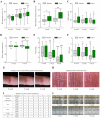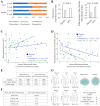Clinical Potential of Novel Microbial Therapeutic LP51 Based on Xerosis-Microbiome Index
- PMID: 39682776
- PMCID: PMC11639849
- DOI: 10.3390/cells13232029
Clinical Potential of Novel Microbial Therapeutic LP51 Based on Xerosis-Microbiome Index
Abstract
Xerosis, characterized by dry, rough skin, causes discomfort and aesthetic concerns, necessitating effective treatment. Traditional treatments often show limited efficacy, prompting the need for innovative therapies. This study highlights the efficacy of microbiome therapeutic LP51, derived from a healthy vaginal microbiome, in improving xerosis. A double-blind clinical trial involving 43 subjects with dry inner arm skin compared the effects of a 2.9% LP51 extract formulation to a placebo over 4 weeks. The LP51 group exhibited a significant increase in stratum corneum hydration (10.0 A.U.) compared to the placebo group (4.8 A.U.) and a 21.4% decrease in transepidermal water loss (TEWL), whereas the placebo group showed no significant change. LP51 also demonstrated benefits in enhancing skin hydration, improving the skin barrier, and exhibited anti-atopic, anti-inflammatory, and antioxidant properties. Safety was confirmed through in vitro cytotoxicity tests. These effects are attributed to the microbiome-safe component in LP51 and its role in improving xerosis, reflected by an increase in the xerosis-microbiome index, defined by the Firmicutes/Actinobacteria ratio. These findings position microbiome therapeutic LP51 as a promising novel treatment for xerosis.
Keywords: Firmicutes/Actinobacteria ratio; microbiome therapeutic LP51; vaginal microbiota; xerosis; xerosis-microbiome index.
Conflict of interest statement
H.-Y.S., S.K., H.S., J.H.H., J.-W.K., S.g.Y., J.H.K., Y.G.C. were employed by the company LABIO, Inc. and have filed a patent related to this research (Application number: 10-2023-0195000) The remaining authors declare that the research was conducted in the absence of any commercial or financial relationships that could be construed as a potential conflict of interest. The company had no role in the design of the study; in the collection, analyses, or interpretation of data; in the writing of the manuscript, or in the decision to publish the results.
Figures







Similar articles
-
A randomized double-blind controlled trial comparing extra virgin coconut oil with mineral oil as a moisturizer for mild to moderate xerosis.Dermatitis. 2004 Sep;15(3):109-16. doi: 10.2310/6620.2004.04006. Dermatitis. 2004. PMID: 15724344 Clinical Trial.
-
Clinical efficacy of a multilamellar cream on skin physiology and microbiome in an epidermal stress model: A controlled double-blinded study.Int J Cosmet Sci. 2024 Aug;46(4):566-577. doi: 10.1111/ics.12950. Int J Cosmet Sci. 2024. PMID: 39113314 Clinical Trial.
-
The 24-hr, 28-day, and 7-day post-moisturizing efficacy of ceramides 1, 3, 6-II containing moisturizing cream compared with hydrophilic cream on skin dryness and barrier disruption in senile xerosis treatment.Dermatol Ther. 2019 Nov;32(6):e13090. doi: 10.1111/dth.13090. Epub 2019 Oct 9. Dermatol Ther. 2019. PMID: 31585489 Clinical Trial.
-
Atopic xerosis: employment of noninvasive biophysical instrumentation for the functional analyses of the mildly abnormal stratum corneum and for the efficacy assessment of skin care products.J Cosmet Dermatol. 2006 Jun;5(2):140-9. doi: 10.1111/j.1473-2165.2006.00241.x. J Cosmet Dermatol. 2006. PMID: 17173589 Review.
-
The Microbiome in Psoriasis and Psoriatic Arthritis: The Skin Perspective.J Rheumatol Suppl. 2018 Jun;94:30-31. doi: 10.3899/jrheum.180133. J Rheumatol Suppl. 2018. PMID: 29858350 Review.
References
-
- Walters K.A., Roberts M.S. Dermatological and Transdermal Formulations. CRC Press; Boca Raton, FL, USA: 2002. The structure and function of skin; pp. 19–58.
-
- Archer C.B. Rook’s Textbook of Dermatology. Wiley-Blackwell Publishing; Hoboken, NJ, USA: 2010. Functions of the skin; pp. 1–11.
-
- Kamakshi R. Fairness via formulations: A review of cosmetic skin-lightening ingredients. J. Cosmet. Sci. 2012;63:43–54. - PubMed
Publication types
MeSH terms
Grants and funding
LinkOut - more resources
Full Text Sources
Molecular Biology Databases

